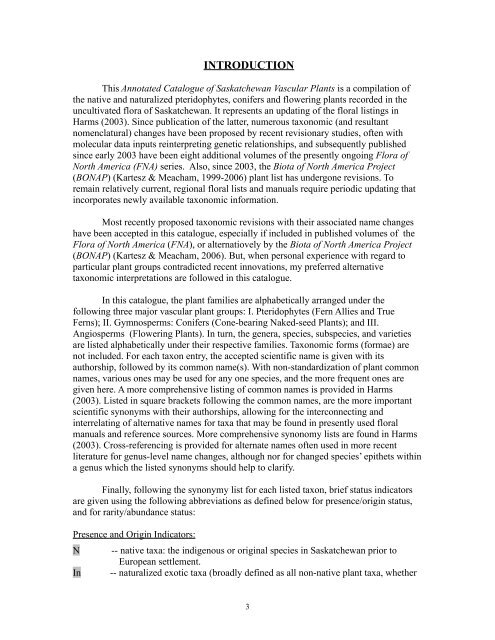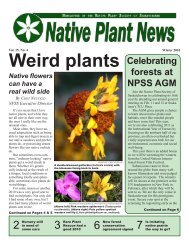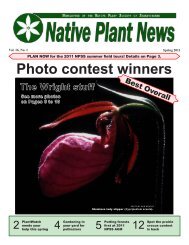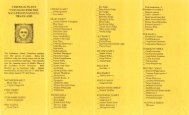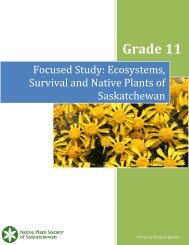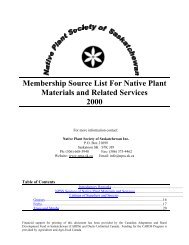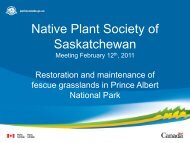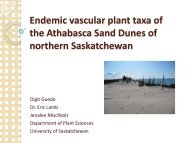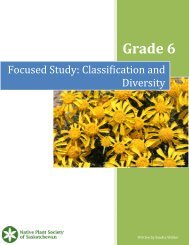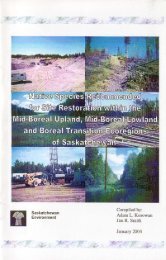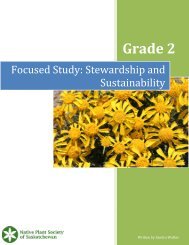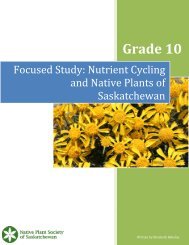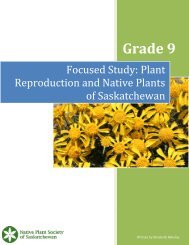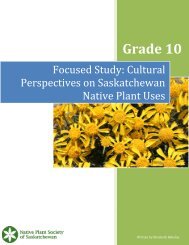Checklist of the Vascular Plants of Saskatchewan - Native Plant ...
Checklist of the Vascular Plants of Saskatchewan - Native Plant ...
Checklist of the Vascular Plants of Saskatchewan - Native Plant ...
Create successful ePaper yourself
Turn your PDF publications into a flip-book with our unique Google optimized e-Paper software.
INTRODUCTION<br />
This Annotated Catalogue <strong>of</strong> <strong>Saskatchewan</strong> <strong>Vascular</strong> <strong><strong>Plant</strong>s</strong> is a compilation <strong>of</strong><br />
<strong>the</strong> native and naturalized pteridophytes, conifers and flowering plants recorded in <strong>the</strong><br />
uncultivated flora <strong>of</strong> <strong>Saskatchewan</strong>. It represents an updating <strong>of</strong> <strong>the</strong> floral listings in<br />
Harms (2003). Since publication <strong>of</strong> <strong>the</strong> latter, numerous taxonomic (and resultant<br />
nomenclatural) changes have been proposed by recent revisionary studies, <strong>of</strong>ten with<br />
molecular data inputs reinterpreting genetic relationships, and subsequently published<br />
since early 2003 have been eight additional volumes <strong>of</strong> <strong>the</strong> presently ongoing Flora <strong>of</strong><br />
North America (FNA) series. Also, since 2003, <strong>the</strong> Biota <strong>of</strong> North America Project<br />
(BONAP) (Kartesz & Meacham, 1999-2006) plant list has undergone revisions. To<br />
remain relatively current, regional floral lists and manuals require periodic updating that<br />
incorporates newly available taxonomic information.<br />
Most recently proposed taxonomic revisions with <strong>the</strong>ir associated name changes<br />
have been accepted in this catalogue, especially if included in published volumes <strong>of</strong> <strong>the</strong><br />
Flora <strong>of</strong> North America (FNA), or alternatiovely by <strong>the</strong> Biota <strong>of</strong> North America Project<br />
(BONAP) (Kartesz & Meacham, 2006). But, when personal experience with regard to<br />
particular plant groups contradicted recent innovations, my preferred alternative<br />
taxonomic interpretations are followed in this catalogue.<br />
In this catalogue, <strong>the</strong> plant families are alphabetically arranged under <strong>the</strong><br />
following three major vascular plant groups: I. Pteridophytes (Fern Allies and True<br />
Ferns); II. Gymnosperms: Conifers (Cone-bearing Naked-seed <strong><strong>Plant</strong>s</strong>); and III.<br />
Angiosperms (Flowering <strong><strong>Plant</strong>s</strong>). In turn, <strong>the</strong> genera, species, subspecies, and varieties<br />
are listed alphabetically under <strong>the</strong>ir respective families. Taxonomic forms (formae) are<br />
not included. For each taxon entry, <strong>the</strong> accepted scientific name is given with its<br />
authorship, followed by its common name(s). With non-standardization <strong>of</strong> plant common<br />
names, various ones may be used for any one species, and <strong>the</strong> more frequent ones are<br />
given here. A more comprehensive listing <strong>of</strong> common names is provided in Harms<br />
(2003). Listed in square brackets following <strong>the</strong> common names, are <strong>the</strong> more important<br />
scientific synonyms with <strong>the</strong>ir authorships, allowing for <strong>the</strong> interconnecting and<br />
interrelating <strong>of</strong> alternative names for taxa that may be found in presently used floral<br />
manuals and reference sources. More comprehensive synonomy lists are found in Harms<br />
(2003). Cross-referencing is provided for alternate names <strong>of</strong>ten used in more recent<br />
literature for genus-level name changes, although nor for changed species’ epi<strong>the</strong>ts within<br />
a genus which <strong>the</strong> listed synonyms should help to clarify.<br />
Finally, following <strong>the</strong> synonymy list for each listed taxon, brief status indicators<br />
are given using <strong>the</strong> following abbreviations as defined below for presence/origin status,<br />
and for rarity/abundance status:<br />
Presence and Origin Indicators:<br />
N -- native taxa: <strong>the</strong> indigenous or original species in <strong>Saskatchewan</strong> prior to<br />
European settlement.<br />
In -- naturalized exotic taxa (broadly defined as all non-native plant taxa, whe<strong>the</strong>r<br />
3


